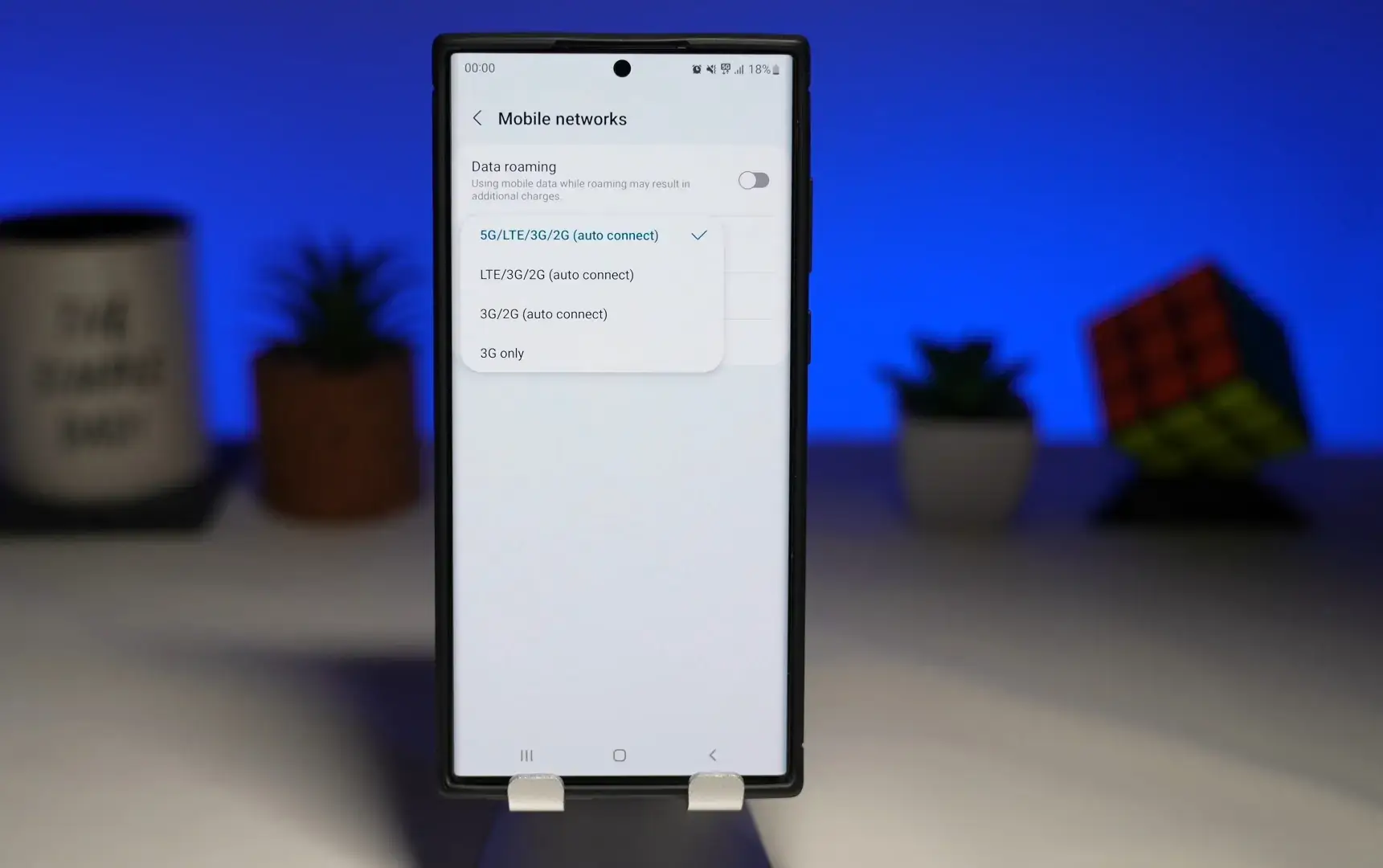Introduction
Are you experiencing connectivity issues or notice that the 5G network isn’t available in your area? Switching from 5G to 4G on your Samsung device is a simple solution that can ensure a stable and reliable network connection. Whether you’re facing network coverage limitations or prefer the benefits of 4G, this guide will walk you through the steps to switch from 5G to 4G on your Samsung smartphone.
Samsung devices offer a user-friendly interface, making it easy to customize your mobile network settings. By following a few simple steps, you can easily switch to 4G LTE and enjoy seamless connectivity wherever you go.
In this article, we will guide you step-by-step on how to switch from 5G to 4G on your Samsung device. By the end of this tutorial, you’ll be able to toggle between network modes and select the one that best suits your needs.
Step 1: Open the Settings Menu
To begin the process of switching from 5G to 4G on your Samsung device, you’ll need to open the Settings menu. This is where you can access various device settings and configurations.
First, unlock your Samsung device and navigate to the home screen. Look for the Settings app, which is represented by a gear icon. Tap on it to open the Settings menu.
The Settings menu is where you’ll find all the options to customize your device, from network settings to display preferences and more. It’s a powerful tool that allows you to tailor your device to your specific needs.
Once you’ve entered the Settings menu, you’re ready to move on to the next step: tapping on “Connections.”
Note: The steps provided in this guide may vary slightly depending on your Samsung device model and software version. However, the general process of switching from 5G to 4G remains the same.
Step 2: Tap on “Connections”
After opening the Settings menu, the next step is to tap on the “Connections” option. This section allows you to manage various network-related settings on your Samsung device.
Scroll down the Settings menu until you locate the “Connections” option. It is usually represented by an icon showing two interconnected circles or a Wi-Fi symbol.
Tap on “Connections” to access the network settings for your Samsung device. Here, you’ll find options related to Wi-Fi, Bluetooth, Data Usage, and more.
The “Connections” section provides a centralized location for managing all your device’s connectivity options. This is where you can modify settings related to your network connections and ensure a seamless browsing experience.
As you enter the “Connections” section, you are now ready to proceed to the next step: selecting “Mobile Networks.”
Note: The exact placement and appearance of the “Connections” option may vary slightly depending on your specific Samsung device model and software version. However, it should generally be located within the Settings menu.
Step 3: Select “Mobile Networks”
Once you have accessed the “Connections” section in the Settings menu, the next step is to select “Mobile Networks.” This option allows you to manage the network settings specifically related to your mobile data connection.
Scroll down the “Connections” section until you find the “Mobile Networks” option. It is typically represented by an icon with a signal tower or a SIM card.
Tap on “Mobile Networks” to enter the network configuration settings for your Samsung device. This is where you can customize how your device connects to mobile data networks.
The “Mobile Networks” settings offer various options for managing your network connection, such as network mode selection, preferred network operators, and APN settings.
By selecting “Mobile Networks,” you are one step closer to switching from 5G to 4G. In the next step, we’ll guide you through the process of choosing the appropriate “Network Mode.”
Note: The exact placement and appearance of the “Mobile Networks” option might differ slightly depending on your Samsung device model and software version. However, it should generally be located within the “Connections” section of the Settings menu.
Step 4: Choose “Network Mode”
After selecting “Mobile Networks” in the “Connections” section of the Settings menu, the next step is to choose the appropriate “Network Mode” for your Samsung device. This setting determines the type of network connection your device will use.
Within the “Mobile Networks” settings, you will find an option called “Network Mode” or “Preferred Network Type.” Tap on it to proceed.
Upon entering the “Network Mode” settings, you’ll see a list of available network modes. These options may vary depending on your device model and carrier, but commonly include options such as 5G/LTE/3G (Auto Connect), LTE/3G (Auto Connect), and 2G only.
To switch from 5G to 4G, you need to select a network mode that supports 4G connectivity. Look for options like LTE/3G (Auto Connect) or LTE Only.
Tap on the desired network mode to select it. Your device will then prioritize that mode for network connections, ensuring a stable and reliable 4G connection.
Once you have chosen the appropriate “Network Mode,” you are ready to proceed to the final step: switching to 4G LTE.
Note: The available network mode options and their names might differ slightly depending on your Samsung device model, software version, and carrier. However, the general concept of selecting the appropriate network mode remains the same.
Step 5: Switch to 4G LTE
Now that you have selected the appropriate “Network Mode” for your Samsung device, the final step is to switch to 4G LTE, ensuring a seamless and stable connection.
Within the “Network Mode” settings, you may find additional options related to 4G connectivity. Look for settings such as “LTE/3G/2G (Auto Connect)” or “LTE Only.”
To switch to 4G LTE, select the option that specifies LTE connectivity. This will ensure that your device utilizes the 4G network for data connections, providing faster speeds and improved performance.
Once you have chosen the 4G LTE option, your Samsung device will automatically connect to the 4G network whenever it is available. This is particularly useful if you want to prioritize 4G connectivity over other network modes.
After selecting the 4G LTE option, you can exit the Settings menu. Your Samsung device is now configured to use 4G as the preferred network mode.
Congratulations! You have successfully switched from 5G to 4G LTE on your Samsung device. Enjoy a stable and reliable network connection for your browsing, streaming, and communication needs.
Note: The steps and the options available within the “Network Mode” settings may vary depending on your Samsung device model, software version, and carrier. However, the general process of switching to 4G LTE remains similar.
Conclusion
Switching from 5G to 4G on your Samsung device is a straightforward process that can help you address connectivity issues and enjoy a stable network connection. By following the steps outlined in this guide, you can easily switch to 4G LTE and ensure a seamless browsing and communication experience.
Throughout this tutorial, we covered the necessary steps to switch from 5G to 4G on your Samsung device. We started by opening the Settings menu and navigating to the “Connections” section. From there, we selected “Mobile Networks” and accessed the “Network Mode” settings. Finally, we chose the appropriate network mode for 4G LTE connectivity.
It’s important to note that the exact layout and naming of settings may vary slightly depending on your Samsung device model and software version. However, the general process remains the same, allowing you to switch to 4G LTE regardless of these variations.
By switching to 4G LTE, you can enjoy faster data speeds, smoother streaming, and improved browsing on your Samsung device. This is especially valuable in areas where 5G network coverage may be limited or when you prefer the reliability of the 4G network.
Remember, it’s always a good idea to check your network coverage and ensure that 4G is available in your area before making the switch. Additionally, keep in mind that the availability of the 4G network depends on your carrier and location.
With the ability to customize and manage your network settings, Samsung devices make it easy to switch between different network modes and adapt to your connectivity needs.
We hope this guide has been helpful in assisting you in switching from 5G to 4G on your Samsung device. Now, you can enjoy a stable and reliable network connection wherever you go!

























